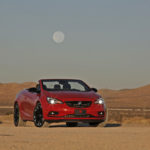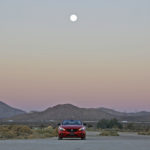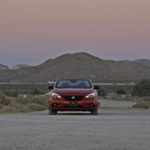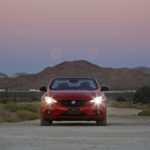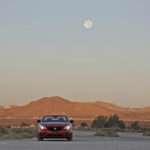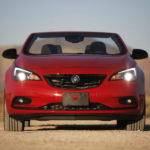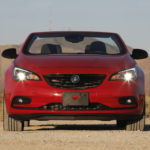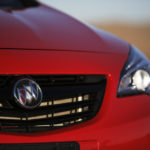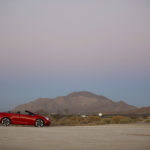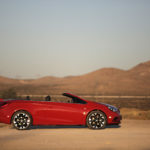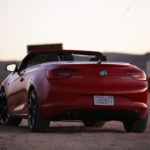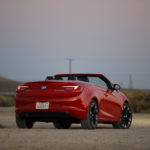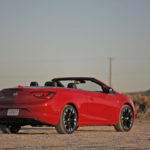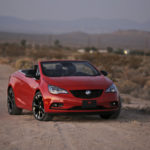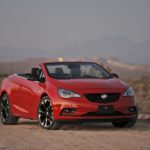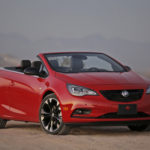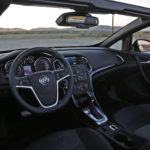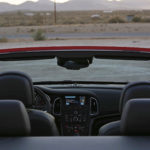Buick Cascada Review: Forbidden Love
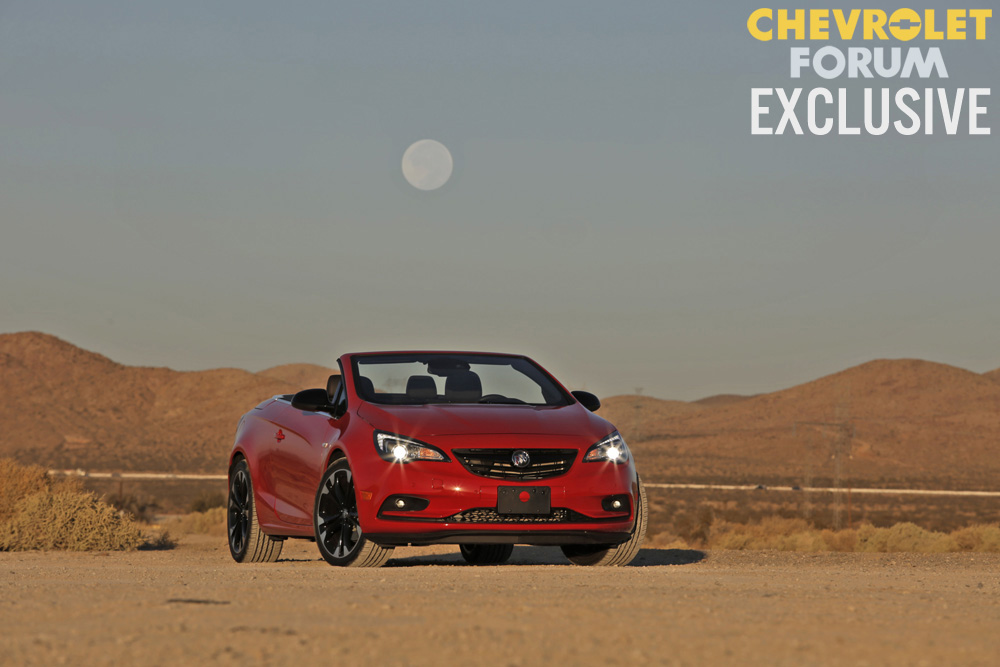
Here is a car so good, it forces you to forgive its four formidable flaws.
It’s a late-fall Sunday afternoon in Southern California. Roadside trees are gargling with golden sunlight. The temperature is 77 degrees, so there’s nary a goosebump raising the hairs on my arms. Meandering in the drop-top Buick Cascada, wind tousling my hair, I feel like I’ve taken a plunge into Sunday’s sweet spot.
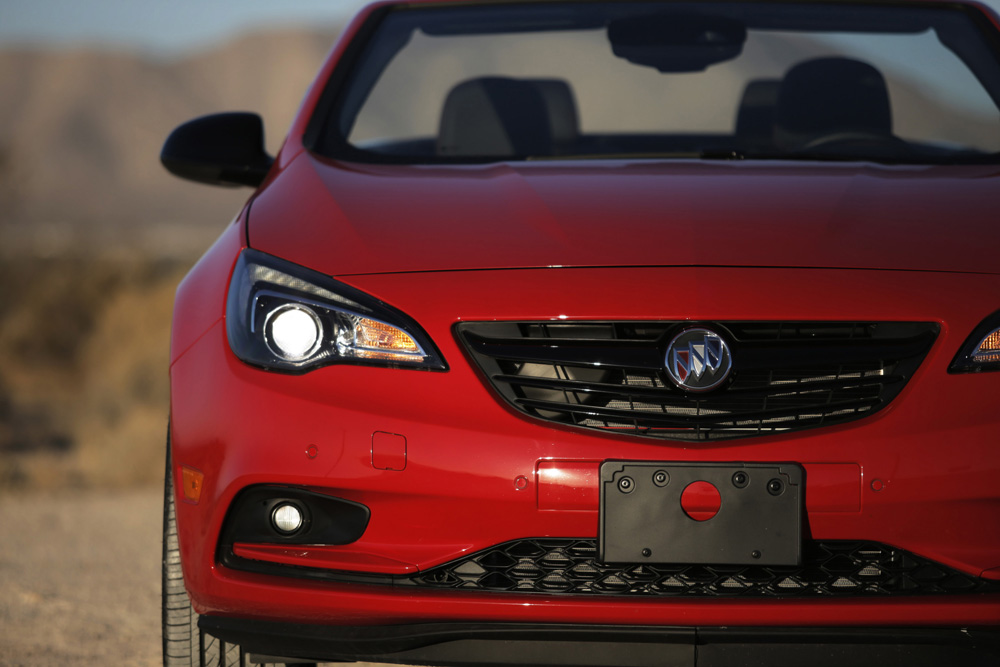
Moments like that make it hard not to fall in love with the Buick Cascada. It’s one of the best cars on sale today for a leisurely Sunday drive. It’s also great for the other six days of the week. If it’s a rainy, traffic-addled Monday morning, the Cascada’s thickly padded soft top will shield you from the outside world when unpleasantness abounds. That multi-layer fabric barrier will leave you cocooned in a tastefully-crafted interior. The dash is nicely stitched together with premium materials, and the heated, quilted leather seats will melt away any worries you have about the day ahead.
Another great thing about the Cascada is the suspension tuning. The Cascada offers an expert balance of sport and comfort that I haven’t felt since the E60 BMW 5 Series. With all the time GM spends tuning its cars on the Nürburgring, it makes sense that this Buick feels class-leading when it comes to suspension sophistication.
I also quite like the way it looks. From certain angles it can look bloated, but that’s understandable. This is, after all, a rebadged Opel/Vauxhall Cascada, which started life as an Opel Astra J; the cousin to the 2008-2016 Chevrolet Cruze. Occasional bloat aside, the Cascada’s overall premium look belies its compact economy car roots. Best of all, if you like to stand out, the Cascada looks like nothing else on the road, including its front-wheel-drive, compact-convertible competition: the Volkswagen Beetle Convertible and the Audi A3 Cabriolet. The Beetle itself looks like nothing else on the road — it’s a “Bug” after all — and the Audi A3 is styled as conservatively as someone who just graduated boarding school.
The Cascada, in contrast, is flashy. It would be downright sexy if it were based off a midsize platform, but alas on an econobox chassis, it’s only good enough to be deemed attractive.

So that’s what’s good about the Buick Cascada Sport Touring. It looks great inside and out, it feels premium and drives great, it’s comfortable on long trips, it’s quiet … even the unbranded audio system sounds good, and holds its own with the top down at 80 mph. Match all of this car’s good points with a Sun-drenched weekend afternoon, and you’ll have nothing but sustained smiles from behind the Buick Cascada’s wheel. In fact, you’ll smile enough to be able to ignore four major blemishes on its otherwise outstanding resume.
The Cascada’s first problem is that it’s depressingly overweight. Even though it is but an inch longer and wider than its Buick Verano platform mate, it makes the scales cry “uncle,” stamping them out with 3,962 pounds of a force more crushing than getting served divorce papers. This hyperbole is warranted. I have genuine feelings for the Cascada, despite the fact that it’s weighted enough to journey to the center of the Earth. Unfortunately, those pounds weigh on my heart, for I can’t help but wonder how remarkable this car would be if it were to weigh the same as the Verano at 3,483 pounds.
A 479-lb. weight-loss isn’t far-fetched. The similarly sized and contented front-wheel-drive Audi A3 Cabriolet is a feathery 3,439 lbs. The VW Beetle Convertible, which rides on the same Volkswagen Group MQB platform as the Audi A3, is a mere 3,216 lbs. Despite the Cascada’s low-brow, twist-trailing-arm, Watt’s linkage rear suspension, I can imagine the Cascada sans 500 lbs. would trounce its VW Group rivals. As it sits now, a full-blown Weight Watchers failure, it already has better suspension tuning than those two Germans. I simper thinking about what it would be like if it could out-handle and out-accelerate them.

And that points to another reason why the Cascada’s weight issue is so depressing. Its lack of empathy for scales is the impetus for its next two problems: terrible acceleration and awful fuel economy. It takes gobs of gas and time to move two tons. Zero to sixty takes 8.3 seconds, but it feels closer to 10, and an LA-to-Palm Springs weekend trip — 97 percent highway — returned 24 mpg. In the city I was lucky to go beyond 17 mpg.
I’m unsure how the EPA certifies the Cascada at 20/27 city/highway. They’ve got the vehicle’s driveline configuration listed bass-ackwards on their website, so their credibility is limited with me when it comes to this car’s consumption figures. Hey, EPA! The Buick Cascada is front-wheel drive, not rear-wheel drive! I wonder if they accidentally used their lax, pre-2008 fuel economy certification regimen to arrive at those numbers. Even if I were able to achieve 20 mpg city/27 mpg highway, that’s still lackluster for a car powered by a 1.6L four-cylinder.
I’m scratching my brains as to why Buick uses the 1.6 for the heaviest car on their GM Delta II platform. Two-hundred horsepower and 221 lb-ft of torque are great for a turbocharged 1.6, but why not use the 250-hp 2.0L from the Verano? Not only would it chip away at the Cascada’s creaky 16.5 seconds down the quarter-mile, but it would also mean the engine would have to labor less during regular driving, meaning better fuel economy. Of course, both of those problems could be solved if the car would just lose some weight.
It would also be nice if the Cascada used modern infotainment. Buick’s IntelliLink, the rebadged version of Chevrolet’s MyLink, is a great system … the 2017 version, that is. Instead, formidable flaw No. 4 is that the Cascada is using a version of Intellilink that debuted in the 2012 model year. The Cascada’s infotainment system is like the car itself: it’s slow. But the outdated infotainment can be downright irritating for someone like me who listens to 99.5 percent of his music on Spotify. I’ll walk you through the irritation. Let’s say you leave the vehicle while playing songs from Spotify on your iPhone. When you get back behind the wheel, the Cascada will begin playing, from the top, the last song you heard … in Apple Music. Or, let’s say you’re listening to Spotify, and you request Siri to read back a text message. When Siri hands it back to the music, whoop, there it is: from the top, that same song sitting in Apple Music. Oh, but what if you get a phone call while listening to Spotify? There comes that song, from the top … again, in Apple Music as soon as you hang up. Nothing against Apple Music. I simply use Spotify, and have only four songs in my Apple Music app. When a car forces you to listen to the first 10 seconds of the Beatles’ “Michelle” 12 times a day, that begins to wear on you like a co-worker’s blaring, played-out ringtone.

Does the Cascada seem like an awful car at this point? I promise, it’s not. It’s genuinely a good car. Catapult your phone into a crematorium, hop into the cockpit without opening the door, and just drive it. It’s good at being a premium convertible. And it’s priced right, too … if you can stick with the base model. Our fully loaded Cascada Sport Touring rings in at $37,990. At that price, the Cascada almost earned itself a fifth formidable flaw, until I discovered that the base Cascada at $33,990 is pretty much loaded with 20-inch wheels, leather, navigation, and a 4G Wi-Fi Hotspot. If you absolutely want forward-collision alert, lane-departure warning and rain-sensing wipers, be my guest and fork over $3,000 for a Cascada Premium.
To save three grand, though, I’d live happily ever after without those niceties. Our Cascada Sport Touring adds another grand to the Premium trim price. The Sport Touring gives you sport alloy pedals, a thicker steering wheel, and a unique set of 20-inch wheels. Yeah, not worth a grand… however, you can only option the stunning (and free) Dark Effects Package with the Sport Touring trim. That actually might be worth it.
After a week and 771 miles with the Buick Cascada, I found it hard to give it back.
So what about the 275-horsepower, 2.0L turbocharged Camaro 1LS at $32,900? It’s $1,090 less expensive, 315 pounds lighter, 2.6 seconds faster to 60, three mpg more efficient on the highway, and is better-looking than the Cascada. It also comes well-equipped with seven-inch (modern) MyLink infotainment, Apple CarPlay, Bluetooth streaming, and a lot more. Then the cheapest Camaro convertible beats the Cascada, right? Overall, yes. It’s the car on which I’d spend my own money, but there’s still a rational case for the Cascada. The Buick is the better cruiser. It’s the more luxurious car, and if that’s what someone is looking for, I can’t blame them for forgoing the Camaro.
Beyond rationality, though, the Cascada can even be an emotional decision over the Camaro. After a week and 771 miles with the Cascada, its formidable flaws notwithstanding, I found it hard to give it back. I developed a personal connection with it, and I’ve tested numerous formidable flaw-free cars this year where it was easy to give back the keys. I’m not sure I’d feel as mushy about a four-cylinder Camaro convertible, especially if I were to own one, and it were to eat away at me that there’d be a bank of four cylinders missing under the hood.
With the Cascada, I’d be free of those feelings of Camaro SS inferiority. I’d simply be free to get in the car, let it be the great convertible cruiser that it is, and forget about life’s worries one messed-up hairdo at a time.

Looking for a good deal on a new Buick? Get insider information here.
Words and photos by Manuel Carrillo III

